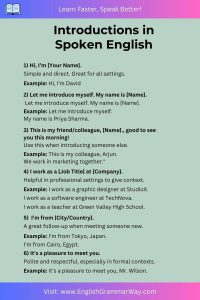Master 7 essential English greetings and introductions. Learn how to speak spoken English fluently with real-life examples and avoid common beginner mistakes!
Greetings & Introductions in Spoken English are very important things. Speaking English confidently begins with one of the most basic skills: Greetings and introductions. Whether you are meeting someone for the first time or chatting with colleagues, knowing how to start a conversation sets the tone for a positive exchange.
In this blog, we’ll cover 5-6 essential examples each for greetings and introductions, ideal for learners who want to speak naturally and avoid awkward mistakes. Ready to boost your everyday English skills?
How to Speak Spoken English Fluently: Why Are Greetings & Introductions Important?
- They create first impressions.
- They help you connect with others.
- They show politeness and professionalism.
- They make conversations feel natural.
Top 6 Examples of Greetings in Spoken English
Here are six useful greetings used in everyday English, from formal to informal.
[1] Hello! How are you?
A classic, polite, and widely accepted greeting. Suitable for both formal and informal settings.
Example: Hello, Sarah! How are you today?
[2] Hi! What’s up?
An informal greeting used with friends or people your age.
Example: Hey Alex! What’s up?
[3] Hey, good to see you this morning!
These time-specific greetings are perfect for professional settings.
Example: Good morning, Mr. Lee. Nice to see you.
[4] Hey there!
Casual and friendly; often used in relaxed environments.
Example: Hey there! Long time no see!
[5] How’s it going?
A conversational and friendly way to ask how someone is doing.
Example: Hi Sam! How’s it going?
[6] Nice to see you! / Nice to meet you!
Used when you’re happy to meet or see someone.
It’s great to finally meet you — I’ve heard a lot about you!
Read More:
- Opposite Words – 200+ for Better English Communication
- 7 Everyday English Mistakes You Must Stop Saying Today!
Top 6 Examples of Introductions in Spoken English
Making a strong introduction helps build confidence and trust. Here’s how to introduce yourself and others naturally.
[1] Hi, I’m [Your Name].
Simple and direct. Great for all settings.
Example: Hi, I’m David.
[2] Let me introduce myself. My name is [Name].
More formal and polite.
Example: Let me introduce myself. My name is Priya Sharma.
[3] This is my friend/colleague, [Name].
Use this when introducing someone else.
Example: This is my colleague, Arjun. We work in marketing together.
[4] I work as a [Job Title] at [Company].
Helpful in professional settings to give context.
Example: I work as a graphic designer at StudioX.
[5] I’m from [City/Country].
A great follow-up when meeting someone new.
Example: I’m from Mumbai, India.
[6] It’s a pleasure to meet you.
Polite and respectful, especially in formal contexts.
Example: It’s a pleasure to meet you, Mr. Wilson.
Tips to Find Natural When Greeting or Introducing Yourself
- Smile and make eye contact.
- Keep your tone friendly and straightforward.
- Use body language that matches your words or focus.
- Try practicing by speaking to yourself in the mirror.
- Common Mistakes to Avoid.
- Using overly formal phrases in casual situations
- Speaking too fast or too softly
- Forgetting to return a greeting
- Not listening actively during an introduction
Bonus: Practice Dialogues with a Friend
Dialogue 1:
A: Good morning! I’m Anjali, the new intern.
B: Good morning, Anjali! I’m Mark. Nice to meet you.
Dialogue 2:
A: Hey, what’s up?
B: Not much! Just heading to class. You?
A: Same here. See you there!
Conclusion
Greetings and introductions are more than words—they set the stage for successful communication. Whether you are in a professional setting or just meeting someone new, using the right phrases with confidence makes all the difference.


